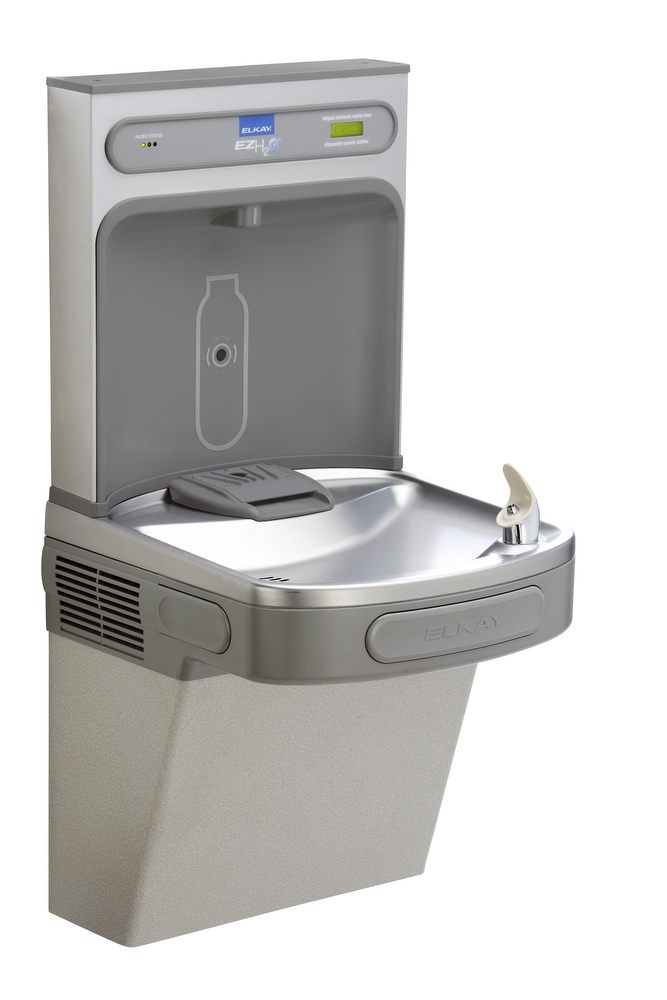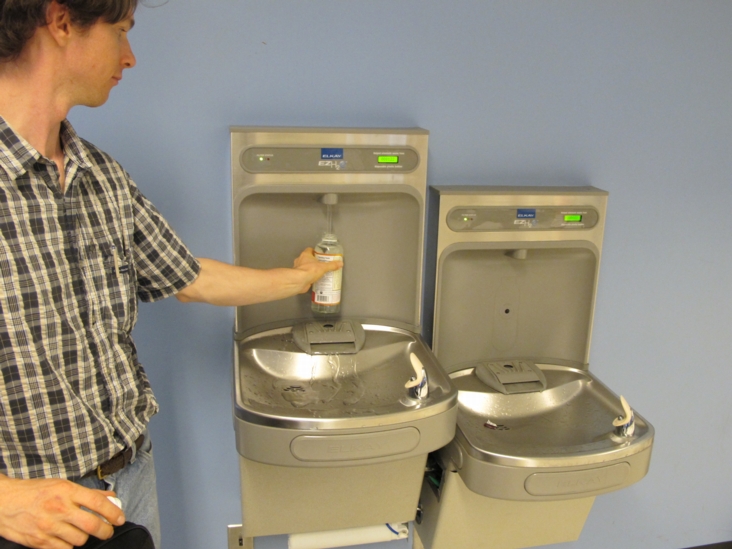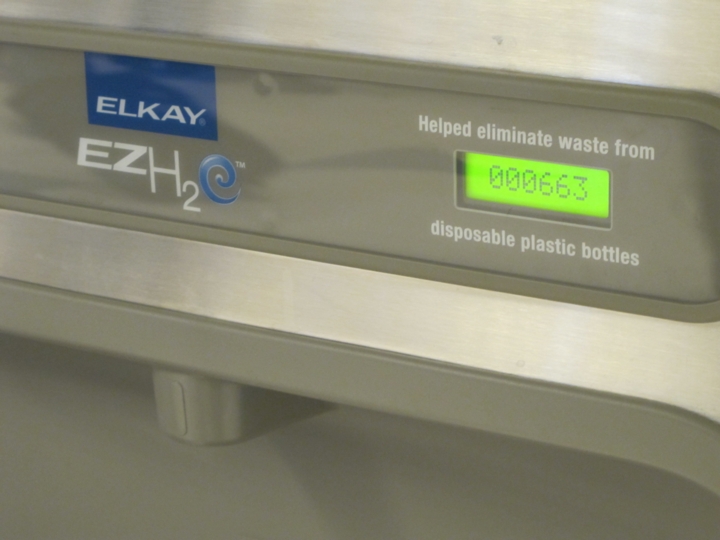I am a bit surprised at the comment that this is a waste of energy. You would need to compare the amount of energy used to cool this bit of water with the amount of energy is used to keep your bottles of water cool, in producing the bottles, in transporting the bottles and then in the disposal process the bottle will eventually go through- or maybe it will just end up in the ocean. In my mind this fountian seems a much better solution. Hope everyone starts carring their own bottles.
also to prevent sweating from the stainless steel bottles get a neoprene sleeve that will also double as a carrier and an insulator...
Blog Post
Bottle-Filling Water Cooler from Elkay

As I always do when I fly, I bring my own stainless-steel water bottle, finishing the contents before going through security, then filling it so that I don't need a plastic water bottle from the flight attendant. When I flew out of O'Hare in Chicago to return home from a meeting the other day, for the first time I filled my bottle from a new Elkay EZH2O bottle filling station.
It's much more convenient. Unlike filling from a standard drinking fountain, it only took one hand, so I didn't have to contort my body to keep my computer bag from slipping off my shoulder as I stooped over and waited for my bottle to fill. It's a lot faster, with a 1.1 gallon-per minute (gpm) fill rate--close to three times that of a standard drinking fountain. And I didn't have to keep raising and lowering the mouth of the bottle to keep the water flowing in as the pressure changed and the stream rose and fell.
Mostly I like the new bottle-filling station for the environmental benefits of avoiding the use of plastic water bottles. Consider:
- The U.S. consumes about 31 billion liters of bottled water per year, at an energy cost of more than 17 million barrels of oil.
- Some 4 billion PET bottles end up in the U.S. waste stream each year, costing municipalities some $70 million for disposal.
- It takes about three liters of water and 3,200 Btus to produce and fill a 1-liter plastic water bottle.
- In 2006, 44% of bottled water in the U.S., including Pepsi's Aquafina and Coca-Cola's Dasani brands, originated as municipal tap water, rather than spring water--so most bottled water is no different from water we get from a drinking fountain.
For an entertaining review of what's wrong with bottle water, see the great online video The Story of Bottled Waterfrom the producers of The Story of Stuff.

Elkay introduced the EZH2O bottle-filling station in February 2010. Gaelen Bell, of the company, told me that they've experienced "tremendous sales of these units" since it was introduced, with more than 1,500 units sold or shipped since launch. According to Bell, the product is "truly changing the landscape and perception of public water fountains."
Several different models are available for both new-installations and retrofit applications. For new installations, an in-wall, stand-alone model is available that can be installed alone or alongside a conventional Elkay Softsides® or SwirlFlo® drinking fountain. (A virtually identical HydroBoost model is available from Halsey Taylor, a subsidiary of Elkay.) These models are available with an Elkay integral 8-gallon chiller or can pair with larger Elkay remote chillers located within 15 feet. (When not used with a chiller, the flow rate is somewhat higher, at 1.5 gpm.)
SUPPORT INDEPENDENT SUSTAINABILITY REPORTING
BuildingGreen relies on our premium members, not on advertisers. Help make our work possible.
See membership options »Retrofit kits are also available to turn a standard "EZ-style" Elkay drinking fountain into a combination model that serves both drinking and bottle-filling.
Operation is sensor-activated, so users don't have to touch anything. The bottle can be held or set down for filling, which takes about six seconds. The unit delivers laminar, rather than aerated, flow making the units appropriate for hospitals (where there is concern that water aeration can aerosolize bacteria). All units meet ADA requirements.

Elkay's EZH2O bottle-filling stations filter water as it is dispensed. The easy-to-replace filter lasts for 3,000 gallons. Green, yellow, and red LED indicator lights on the unit alert custodial staff that replacement is needed. The plastic components surrounding the dispensing area are infused with a silver-ion antimicrobial material that helps to eliminate mold or bacteria.
Another nice feature is a "green ticker" that reports how many 16-ounce bottles (12-ounce bottles for chilled-water models) have been filled. The dispenser I filled my bottle with at O'Hare had saved 8,100 plastic water bottles in the short time since it had been installed, the lower one next to it, 660.
For more information:
Elkay Manufacturing Company
Oak Brook, Illinois
630-572-3192 (customer service)
consumer@elkay.com (e-mail customer service)
Alex Wilson is the executive editor of Environmental Building News and founder of BuildingGreen, LLC. In addition to this product-of-the week blog, he writes the weekly Energy Solutions blog. To keep up with his latest articles and musings, you can sign up for his Twitter feeds. Products covered in his product-of-the-week column are--or soon will be--listed in BuildingGreen's GreenSpec database.
See more on this product in the GreenSpec Guide
Published July 30, 2010 Permalink Citation
(2010, July 30). Bottle-Filling Water Cooler from Elkay. Retrieved from https://www.buildinggreen.com/blog/bottle-filling-water-cooler-elkay
Comments
I am a bit surprised at the c
I inquired to Elkay with rega
I inquired to Elkay with regard to the refrigerant used and the electrical energy consumption of the units and promptly received the reply below.
The EZH2O unit comes in both non refrigerated and refrigerated versions. For the non-refrigerated versions of the base units themselves, there is very little energy draw. While the unit is idle it will draw 0.01 amps, and when it is activated it will draw 0.09 amps.
For the refrigerated systems in both models we offer our standard 8 gallon/hour refrigeration packages either as an EZ cooler mounted to the wall, or a chiller mounted within the wall for the in wall versions. For these refrigerated systems, we use 4.1 oz. of R124a refrigerant. As for the energy consumption, we have tested our units to CSA standard C-815 (Energy Performance of Drinking Water Coolers). Per this standard, the refrigeration package consumes 1.19kW-hr per day and 434.35kW-hr per year.
Please let me know if I can provide any additional information.
Franco Savoni, P.Eng., PMP
Senior Product Manager
Drinking Water and Refrigeration Solutions
Ph: 630-574-8647
Cell: 630-274-8079
Fax: 630-645-4436
These water fountains can be
These water fountains can be installed without the chiller--but still with filtration. I actually prefer non-chilled water, as I put my stainless-steel water bottle in my computer bag, and it would be great if it didn't sweat! I didn't find out from Elkay what percent of installations go in without chillers--my guess is that it's a pretty low percentage (unfortunately).
When I saw these units starti
When I saw these units starting to be installed at our university I thought "what a waste of energy". We now expect that fountain water needs to be chilled. I think the move toward more chilled water fountains will have net negative impact on the environment because they are a waste of energy and there is a potential for refrigerant leak. I agree that they are handy but I would appreciate your thougts on my comments. Is this a hybrid SUV?
It is unrealistic to expect m
It is unrealistic to expect most people to want to fill their water bottles with hot or warm water. The all or nothing approach of the last comment illustrates the reason why the mainstream is already tired of the green movement.
In the real world, most people want a drink of cold water on a hot summer day. I think this new drinking fountain and bottle filler concept is smart! I would certainly use it if the water were chilled. If not I would probably go to the nearest store and buy a cold bottle of water -- especially when I am riding my bike in 95 degree temperatures like I did a lot of this summer across Iowa, Nebraska and Colorado. So, I just save an incredible amount of fossil fuels by bicycling 2,000 miles and I can't have a drink of cold water because you think it will waste energy?
That is definitely cool! I f
That is definitely cool! I fly probably 10 times a year, and have yet to see one of these fountains. Just by looking at one, I feel compelled to bring my own water bottle. I have always been weary of drinking fountains because of germs, but this looks pretty legitimate. It would encourage me to bring a reuseable bottle instead of buying a plastic one. This fountain should definitely be promoted in the environmentally friendly world :)
Alex, it's true, and quite a
Alex, it's true, and quite a cool product. It makes me wonder to what degree it encourages purchase of bottle water/soda in the first place, as a seemingly small percentage of consumers actually carry reusable bottles with them. On the other hand, since you can't bring in liquids to the airport but can bring in empty bottles, if the foundation is just after security and is clearly marked, it could limit purchase of bottled beverages in the first place. Airports could also demonstrate their commitment to green by selling at a subsidized cost a stainless-steel or other reusable bottle. In general this fountain does more good than harm, but if it were supported by a holistic commitment to reducing waste (even volume of plastic recyclables), it would have a much greater impact. Oh, and do you think the green ticker can convert the number of bottles into tons of GHG? Aaron



Add new comment
To post a comment, you need to register for a BuildingGreen Basic membership (free) or login to your existing profile.